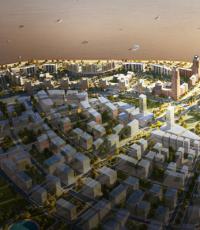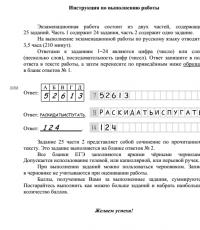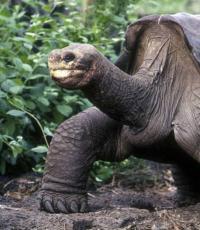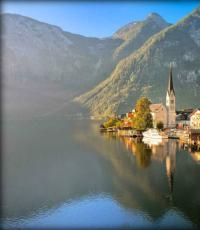Four artificial islands will be created in the Barents Sea. New land: why artificial islands are used in Russia Strategic investment project
Russian Prime Minister Dmitry Medvedev signed a decree on the creation of four artificial islands in the Kola Bay of the Barents Sea. According to experts, this will greatly simplify the development of mineral deposits located in this region. However, this is not the first such project in Russia. RT found out for what other purposes a new land is being created.
- © Wikimedia / Tom Thiel
Four artificial islands will be created in the Kola Bay of the Barents Sea. The corresponding order was signed on June 15 by Russian Prime Minister Dmitry Medvedev. The construction of new islands was entrusted to the company "Kola Shipyard"
On the islands themselves, a "Center for the Construction of Large-tonnage Offshore Structures" will operate, where complexes for offshore mining will be created.
"The center is intended for the manufacture of offshore complexes for the production, storage and shipment of liquefied natural gas and stable gas condensate on gravity-type bases, offshore production complexes, as well as the repair and maintenance of offshore equipment and machinery used for the development of offshore oil and gas condensate fields," cabinet website.
Kola Shipyard is a subsidiary of Novatek, which decided to invest 25 billion rubles in the project. The project will help create about 10,000 jobs and attract new investment to the region.
Experience is available
Russia began to create artificial islands several centuries ago, both for the expansion of territories and for military purposes. At the beginning of the 18th century, Turtle Island was built in the Sea of \u200b\u200bAzov, where the citadel was located. Later, the island lost its strategic importance, but today, at low tide, you can still see parts of it.
And today in Russia, the creation of artificial land plots is actively underway. Roman Pukalov, director of environmental programs at the Green Patrol, noted that there are already similar successful projects in Russia. So, bulk dams were created in the Kerch Strait during the construction of the Crimean bridge.
“There were similar projects, the same Tuzla Spit, which goes from Taman towards Kerch, is largely an artificial structure. While building the Kerch bridge, the spit expanded, filled up and changed,” the expert explains.
- globallookpress.com
- © Serguei Fomine
The bridge across the Kerch Strait will connect the Crimea and the Krasnodar Territory. It is planned that it will become the longest in Russia. Its length will be 19 km. Motorists will be able to test the new bridge in December 2018.
As RT reported, the builders have already completed the assembly of the railway arch.
Projects for a better life
In 2006, the expansion of the western part of Vasilyevsky Island began in St. Petersburg. The area of the new territories of the island will be about 476 hectares. The Sea Façade project is one of the largest coastal development projects in the world.
- © www.mfspb.ru
The expansion of the island has not yet been completed, but a specialized seaport is already operating there, which is popular among foreign tourists.
In the future, residential buildings, schools, hospitals and commercial facilities will also be built on this part of the island.
Solving many problems
As Director of the Energy Development Fund Sergei Pikin notes, this is an important step for Russia, since at the moment there are not so many such projects in our country. In addition, according to the expert, artificial land plots will help simplify the extraction of natural resources, since the necessary complexes will be located on them.
"The system of building artificial islands is the most beneficial, because it will help solve many problems related to infrastructure," the expert believes.
Ecologist Roman Pukalov notes that such construction requires not only a well-thought-out project, but also an independent environmental review.
“The Kola Bay is a natural environment, you need to carefully look at how the current flows along the bay itself, whether this will interfere with the movement of aquatic organisms, how long the work will be done in order to avoid the disturbance factor during the spawning period. This needs to be thought through very carefully,” the ecologist says.
Russian Prime Minister Dmitry Medvedev approved a plan of priority measures for the creation in the Barents Sea of the Center for the construction of large-capacity offshore structures - artificial islands, on which gas production will be carried out, as well as the operation and repair of marine equipment.
"The center is intended for the manufacture of marine complexes for the production, storage and shipment of liquefied natural gas (LNG) and stable gas condensate on gravity-type bases, offshore production complexes, as well as the repair and maintenance of marine equipment and equipment used for the development of offshore oil and gas condensate fields", - is indicated in the message of the Cabinet.
The document also explains that the construction of artificial land plots in the waters of the Kola Bay is necessary to accommodate the facilities of the center. Artificial land plots will be created at the expense of Kola Shipyard LLC's own funds. The volume of capital investments under the project will amount to more than 25 billion rubles.
“LLC “Kolskaya Verf” received permission from Rosmorrechflot to create artificial land plots on a water body. By the signed order, Kola Shipyard LLC has been designated as the person with whom Rosmorrechflot will conclude an agreement on the creation of four artificial land plots in the Kola Bay of the Barents Sea, ”the text explains.
In addition, the explanatory note says that the construction of the center will create about 10,000 jobs at the shipyard itself, increase tax revenues to the budgets of all levels, attract additional investment to the region, and develop new high-tech industries.
The administrative address of the object will be the village of Belokamenka of the closed administrative-territorial formation of Aleksandrovsk, Murmansk region. In addition, it recommended that the federal executive authorities, the authorities of the Murmansk region and local self-government help in reducing the time for registration of land plots for the construction of the center, as well as the time for conducting examinations and issuing permits. Local authorities were also asked to consider granting tax breaks on taxes.
Construction in Belokamenka will be carried out as part of the Arctic LNG project, which involves the production of 16.5 million tons of liquefied natural gas per year. The resource base for it will be the Gydan fields. Denis Khramov, Deputy Chairman of the Board of NOVATEK, said earlier that, together with Yamal LNG (the company's second LNG project of similar capacity), Arctic LNG would be able to occupy about 7% of the global liquefied gas market.
In July 2015, the Russian Minister of Natural Resources addressed a letter to the Prime Minister in which he took the initiative to review the existing restrictions on the access of non-state companies to the Murmansk gas field in the Barents Sea.
According to Donskoy, after the decree of the President of Russia on the liberalization of access to the shelf, he submitted proposals on this topic to the government for consideration, but the final decision was not made. The President, who, along with Gazprom, was issued documents giving the right to explore and develop fields, had previously protested against the appearance of other companies on the shelf.
According to the director of Small Letters, the shelf field in Murmansk will be effective only as a project focused on the export of liquefied natural gas. At the moment, Rosneft and Yamal LNG have permission to export LNG.
A year earlier, it was reported that Gazprom and Rosneft received the rights to two offshore areas.
In August 2014, Gazprom received the right to use the Kheysovsky subsoil block with an area of 83,590 sq. km, located in the Barents Sea. Inferred resources for oil - 393.7 million tons (geological resources) and 118.1 million tons (recoverable resources), for gas - 2081.4 billion cubic meters. m, for condensate - 32.6 million tons (geological resources) and 22.8 million tons (recoverable resources). At the same time, Rosneft was granted the rights to use the Pritaymyrsky subsoil block with an area of 20,619 sq. km in the Laptev Sea. The Taimyr area has predicted geological oil resources of 348.6 million tons, recoverable resources - 104.6 million tons, gas - 362.8 billion cubic meters. m.
Four artificial islands will be created in the Kola Bay of the Barents Sea. The corresponding order was signed on June 15 by Russian Prime Minister Dmitry Medvedev. The construction of new islands was entrusted to the Kola Shipyard company.
On the islands themselves, a center for the construction of large-tonnage offshore structures will operate, where complexes for offshore mining will be created.
“The center is intended for the manufacture of offshore complexes for the production, storage and shipment of liquefied natural gas and stable gas condensate on gravity-type bases, offshore production complexes, as well as the repair and maintenance of offshore equipment and equipment used for the development of offshore oil and gas condensate fields,” cabinet website.
Kola Shipyard is a subsidiary of Novatek, which decided to invest 25 billion rubles in the project. The project will help create about 10,000 jobs and attract new investment to the region.
Experience is available
Russia began to create artificial islands several centuries ago, both to expand its territory and for military purposes. At the beginning of the 18th century, Turtle Island was built in the Sea of \u200b\u200bAzov, where the citadel was located. Later, the island lost its strategic importance, but parts of it can still be seen at low tide.
And today in Russia, the creation of artificial land plots is actively underway. Roman Pukalov, director of environmental programs at the Green Patrol, noted that there are already similar successful projects in Russia. So, bulk dams were created in the Kerch Strait during the construction of the Crimean bridge.
“There were similar projects, the same Tuzla Spit, which goes from Taman towards Kerch, is largely an artificial structure. When the Kerch Bridge was being built, the spit expanded, filled up and changed,” the expert explains.
- globallookpress.com
- Serguei Fomine
The bridge across the Kerch Strait will connect the Crimea and the Krasnodar Territory. It is planned that it will become the longest in Russia. Its length will be 19 km. Motorists will be able to test the new bridge in December 2018.
The builders have already completed the assembly of the railway arch.
Projects for a better life
In 2006, the expansion of the western part of Vasilyevsky Island began in St. Petersburg. The area of the new territories of the island will be about 476 hectares. The Sea Façade project is one of the largest coastal development projects in the world.

- www.mfspb.ru
The expansion of the island has not yet ended, but a specialized seaport is already operating there, which is popular with foreign tourists.
In the future, residential buildings, schools, hospitals and commercial facilities will also be built on this part of the island.
Solving many problems
As Director of the Energy Development Fund Sergei Pikin notes, this is an important step for Russia, since there are not so many such projects currently operating in our country. In addition, according to the expert, artificial land plots will help simplify the extraction of natural resources, since the necessary complexes will be located on them.
“The system of building artificial islands is the most advantageous, because it will help solve many problems related to infrastructure,” the expert believes.
Ecologist Roman Pukalov notes that such construction requires not only a well-thought-out project, but also an independent environmental review.
“The Kola Bay is a natural environment, you need to carefully look at how the current flows along the bay itself, whether this will impede the movement of aquatic organisms, how long the work will be carried out in order to avoid the disturbance factor during the spawning period. This needs to be thought through very carefully,” the ecologist says.




